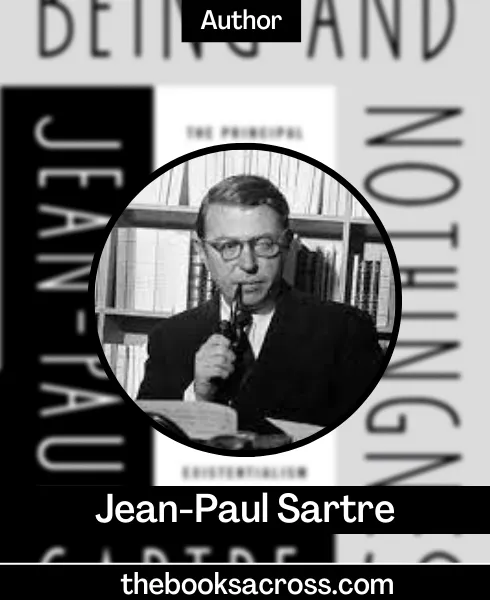Being and Nothingness PDF: An Essay on Phenomenological Ontology (French: L’Être et le Néant : Essai d’ontologie phénoménologique), sometimes published with the subtitle A Phenomenological Investigation into the Essence of Consciousness, is a 1943 book by the French philosopher Jean-Paul Sartre, in which the author seeks to assert the existence of being and investigate the nature of nothingness. It is considered one of the key texts of existentialism and phenomenology, and has been called “one of the most important philosophical works of all time.”
The book was originally published in 1943 by Les Éditions Gallimard, in Paris. It was translated into English and published in 1956 by Philosophical Library, in New York. The book explores the ontological nature of being and nothingness. Sartre examines consciousness, the self, and free will.
The work has sold over half a million copies and has been translated into many languages. It continues to be studied in universities and colleges around the world. Being and Nothingness was well received by the critics when it was first published. It is available in multiple formats including hardcover, paperback, pdf, eBook, and audiobook.
Table of Contents
Being and Nothingness Summary
In Being and Nothingness, philosopher Jean-Paul Sartre examines the nature of human existence and provides a detailed analysis of the concept of “nothingness.” He begins by discussing the nature of consciousness, asserting that it is always directed towards an object. This object may be something external, such as a person or a thing, or it may be an internal object, such as a memory or a thought.
Sartre then goes on to analyze the different ways in which we can perceive objects, asserting that there are two main types of perception: reflective and unreflective. Reflective perception is when we are aware of our own consciousness, while unreflective perception is when we are not aware of our own consciousness. Sartre also discusses the nature of emotions and how they are related to our perceptions of objects. He asserts that emotions are not simply reactions to external stimuli, but rather they are a part of our consciousness and should be considered as such.
Finally, Sartre turns to the question of what it means to exist, and he asserts that existence is nothingness. He argues that our consciousness of ourselves as existing beings is actually a consciousness of our own nonexistence.
Details of Being and Nothingness Book
| Book | Being and Nothingness |
| Author | Jean-Paul Sartre |
| Original language | English |
| Originally published | 1943 |
| Category | Non-Fiction |
| Publisher | Éditions Gallimard |
| Total Pages | 638 |
| Format | PDF, ePub |
Multiple Languages Editions of Being and Nothingness Book
It has been translated into many languages, but most notably into English by Hazel Barnes.
| Book Editions | Check Now |
|---|---|
| English | Check Price |
| German | Check Price |
| French | Check Price |
| Spanish | Check Price |
| Chinese | Check Price |
About the Author
Jean-Paul Sartre was a French philosopher, playwright, novelist, political activist, biographer, and literary critic. He was one of the key figures in the philosophy of existentialism and phenomenology, and one of the leading figures in 20th-century French philosophy and Marxism. His work has influenced sociology, critical theory, post-colonial theory, and literary studies, and continues to influence these disciplines.

Sartre was born in Paris as the only child of Jean-Baptiste Sartre, an officer of the French Navy, and Anne-Marie (née Schweitzer). His father died in 1884 at the age of 38 when Sartre was less than a year old. Anne-Marie moved with her son to La Havre in 1887.
When he was four years old, Sartre began his schooling at the public elementary school Lycée Pasteur, but after two years there, he was admitted to the elite lycée Henri-IV on rue des Sts. Pères in Paris.
Sartre was involved in literary and philosophical groups from a young age, among them the Cubists and the Surrealists. He joined the French Communist Party in 1924, but left it in 1926 due to disagreements with its policies. After a period of “philosophical wanderings”, he wrote Being and Nothingness (1943), his best-known work.
Being and Nothingness PDF Free Download
Here is the pdf file of the Being and Nothingness book available for free to download. Just click on the download button below.
Similar Books to Being and Nothingness Book
- Nausea
- No Exit
- The Flies
- The Wall
- Dirty Hands
- The Critique of Dialectical Reason
- Notebooks for an Ethics
- Existentialism is a Humanism
FAQs (Frequently Asked Questions)
What is the point of Being and Nothingness?
Sartre’s aim in Being and Nothingness is to articulate the nature of freedom and to show how a man can be both free and determined.
Is Being and Nothingness a good book?
Being and Nothingness is considered by many to be one of the most important philosophical works of the 20th century.
What is the reading level of the Being and Nothingness book?
The reading level of Being and Nothingness book is college level.
What is the main theme in the book Being and Nothingness?
The main theme of Being and Nothingness is the nature of freedom.
How long does it take to read Being and Nothingness?
Being and Nothingness can take anywhere from 15-20 hours to read.
How many pages are in the Being and Nothingness pdf?
The Being and Nothingness pdf has 544 pages.







